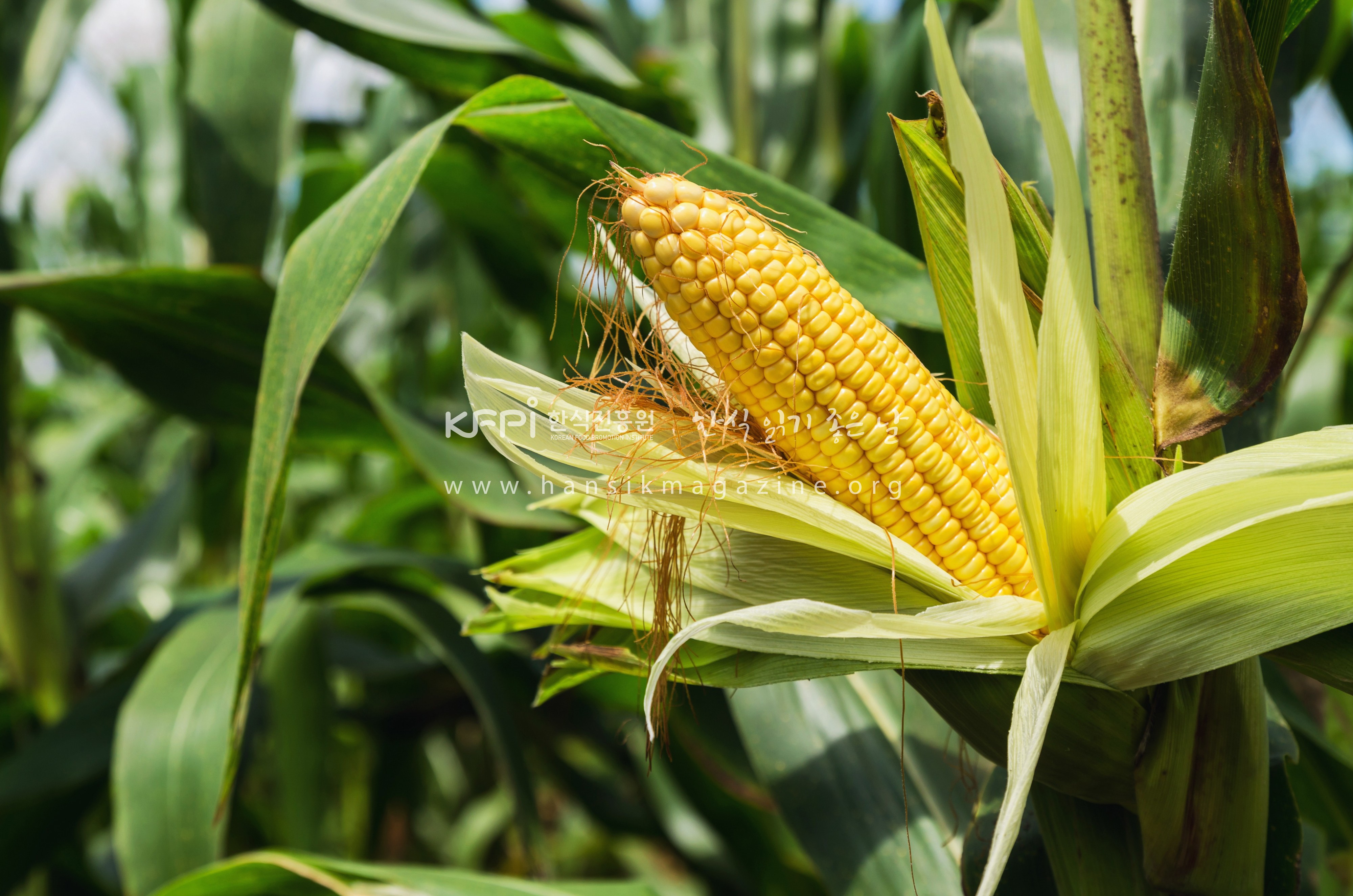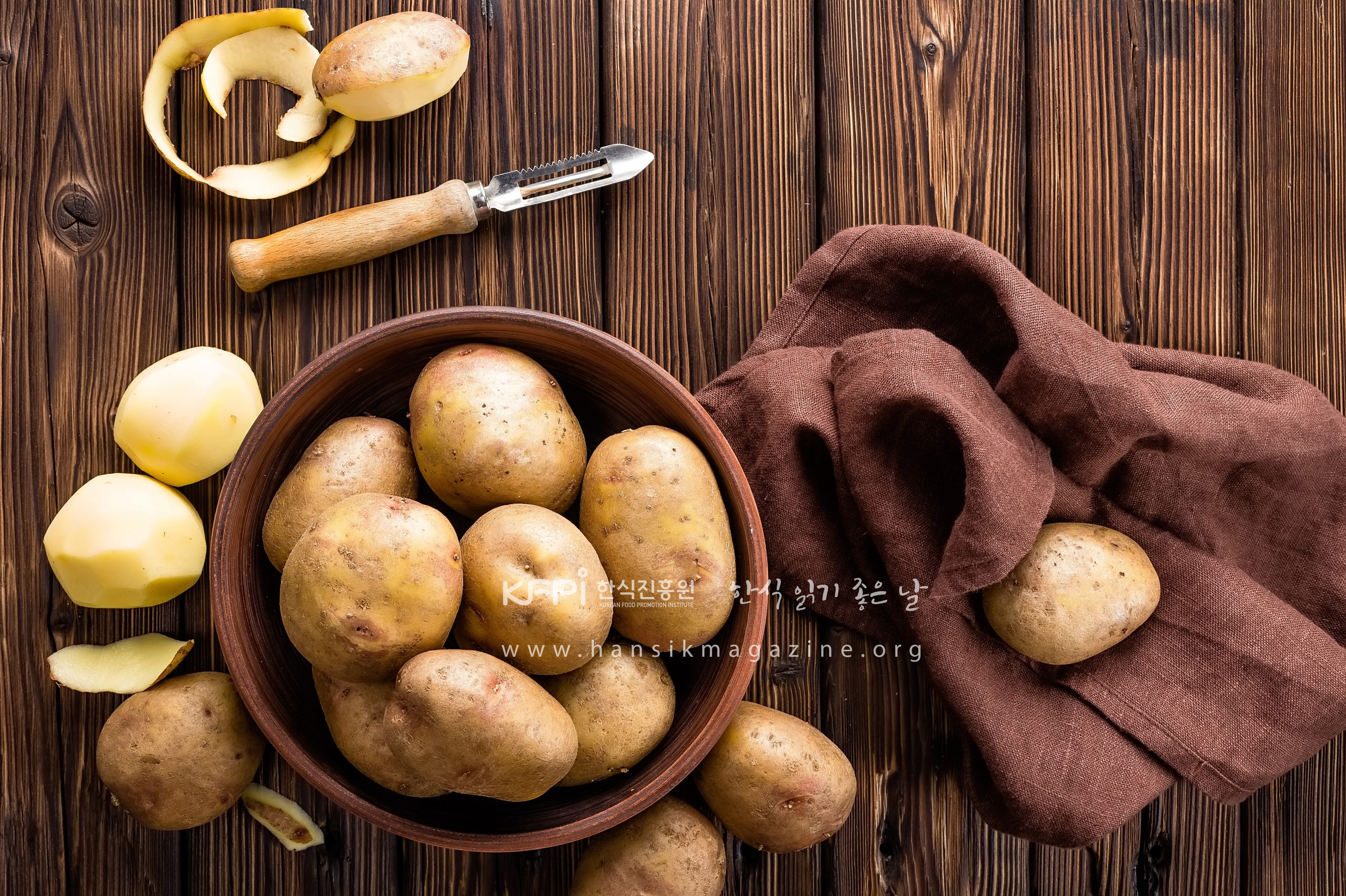한식 읽기 좋은 날
Vol 29. Corn & Potato
Oksusu and Gamja, the taste of waiting with preservation of summer
Gourmet travel for regional food ingredients
Hansik glossary
Oksusu - Corn
Gamja - Potato
When it comes to the winner of the taste in summer,
what can beat between the oksusu grown fully receiving summer sunlight
and the gamja grown with the energy of the earth over 100 days?
I can't help thinking of oksusu(corn) and gamja(potato) in terms of things enriching our summer lives. Oksusu and gamja are crops that have been filling the hungry stomachs of the poor people since ancient times and have turned into great side dishes with poor cooking skills. It is nowadays that we can taste steamed and canned oksusu anytime throughout a year and easily find gamja anytime with ease as well. However, when it comes to the winner of the taste in summer, what can beat between the oksusu grown fully receiving summer sunlight and the gamja grown with the energy of the earth over 100 days?
Even the oksusu in the vast cornfield that I met on the pilgrimage route in Santiago where I walked last summer, couldn't surpass the fully sticky taste that we harvested and steamed during the midday of our summer. The potato salad I ate at the Spanish restaurant also had a quite different taste from the soft and sweet flavor of our potatoes during the Haji season(the summer solstice).

I learned by boiling oksusu that all good things come after waiting.
Everyone may have a memory of oksusu and gamja as ordinary foodstuffs that grew up with the energy of summer in our land. When I was young, I used to steam and ate oksusu at the stream. Albeit there was a cumbersome of preparing a pot and collecting wood branches to make fire, it was a willingness to eat delicious oksusu. After stacking stones in a corner of the stream and putting a pot on them, the branches rolling around gathered together to make a fire, I poured water in the pot for the oksusu to be slightly submerged and pressed the lid on it and waited for it to be cooked. I learned by boiling oksusu that all good things come after waiting. Oksusu needs a long waiting time so that the texture and sweet taste and pleasantly salty taste penetrated into the grains of the oksusu. All good things come late, so I waited patiently for the oksusu on the fire to ripen. Waiting for a long time, the sweet smell coming out of the oksusu boiled brought me back. When I bit the ripened oksusu in my mouth, cracked grain of the oksusu stuck to my lips. If I bite and chewed and swallowed the oksusu grain that clung to the roof of my mouth, the sweetness of the oksusu remained in my mouth for a long time. A lot of things would be okay when my hungry belly became thick with oksusu grains.
When I felt a little tired of my life and my passion was lowered down, I had time to endure it with the fun of eating steamed oksusu. At the time of my second childbirth and postpartum care and when I endured the demise of my life disappearing behind my mother's role allowing the baby to suck my breast, I was eating oksusu instead of seaweed soup. The smell of steamed oksusu, on the road to Daegwanlyeong, travelling without any summer plans, made me more impressed than any other wonderful scenery. Could the imported oksusu with a lot of moisture be compared to it? The Gangwon-do origin glutinous oksusu I tasted pleasantly moving from Pyeongchang to Hongcheon had a special stickiness not inferior to that of sweet rice cake, hadn't it? It was my special trip that replenished my life by eating the oksusu that stuck to the mouth.
Oksusu growing well everywhere
Oksusu is the plant that grows very well even in a barren land. The planting period varies according to the region from April to July. It is also characteristic of oksusu that the planting period is long. In the past, dried oksusu grains were used as seeds for the next year, but nowadays, seeds and seedlings are often bought and planted. 2-3 months after the planting date, the cornstalk grows more than 2 meters and four oksusu are opened in a stalk. The female flower of oksusu is commonly called corn beard. When the beard is properly dried, it can be considered that the oksusu is riped well.
As it is not affected by the quality of soil or water and its growth period is short, oksusu is grown anywhere in Korea's rural villages. There are many mass-production areas, but it has often grown on a small scale in the garden near the house. Oksusu is originated from the American Continent. However, much more delicious and popular is the sticky oksusu seed that has improved western oksusu and was introduced to Korea through Europe. Oksusu grown in different parts of Europe and oksusu in Korea are different from the beginning in terms of stickiness. Compare with foreign oksusu characterized by having yellow and soft skin, Korean oksusu has many varieties and its fully filled inside, such as white, black, and yellow. It is one of the three major crops along with rice and wheat and an economical crop that can be easily cooked and eaten without going through the cooking process like rice or wheat. In the poor Korean 50s and 60s, it was oksusu which was great food to solve meals instead of rice. Even with plenty of food to eat nowadays, it is still beloved as a delicious snack to eat in the summer.

Oksusu, which is likely to be eaten only by steaming, can be cooked in a variety of ways. It is so delicious if you sprinkle oksusu grains and saute them with butter and some salt and pepper in a frying pan, and then take them with a spoon instead of rice. For children, oksusu grains are mixed with mayonnaise and a spoonful of honey, spread on a griddle, and cooked with mozzarella cheese, and then cooked it, and then it will make a children's favorite oksusu-cheese teppanyaki like Michelin-starred dish. If you get tired of eating, put oksusu grains instead of soybeans to cook rice. If you add oksusu grains to Oinaengguk(Chilled cucumber soup), it becomes another delicacy. Oksusu is delicious no matter how you eat it.
This year, COVID-19 has stopped all the trips. I want to order a lot of sticky oksusu as farmers are also having hard times with the pandemic. I will order either oksusu from Hongcheon, which I have tasted fabulously sticky and sweet, or oksusu from my hometown, Mungyeong, or oksusu from a farmhouse in Okcheon, which has been rumored delicious to me. I have to say I want oksusu shyly like an old lover who bravely picks up the phone after waiting for a year.
One day, when a oksusu bag arrives as a gift, I will peel off and steam oksusu with excitement. I wish it is a very hot day. I will recall that the heat of the hot sun covers the heat of steaming oksusu and in the heat, the good things in life will come out slowly, passing through a long time. I guess if I endure the time for the oksusu to be cooked, I may have the energy to live a new daily routine which has been changed due to the COVID-19.

Taste of gamja dug to harvest in summer
It is usual gamja(potato) are respectively planted in spring and fall. Talking about the taste, the gamja dug in summer is more delicious. As gamja are usually planted after mid-March since they must be harvested from late June to early July when the rainy season begins. These days, about 100 days of growth after planting, we can eat delicious gamja in summer. Gamja are also beloved by everyone because they are economical eatery that can be taken immediately without going through a special cooking process. In the poor times when you filled your hungry stomach with them, whereas it became popular as a low-calorie, full-satisfaction crop. Because it contains a large amount of vitamin C, it helps to relieve fatigue, and magnesium contained in gamja activates the production of serotonin, which helps sleep well, as it is very effective for insomnia. If you need to soothe your sunburnt skin after a vacation swimming in the water, you may thinly slice gamja and paste them on the skin to release the heat. It is also a very good crop for health due to its anti-aging effect preventing aging and improving your skin in various aspects.
In summer, the Haji gamja, which are consumed on a box basis, serve as a side dish for a few days without having to shop for foods at the market. Gamja are too friendly eatery as much as I, a poor cook, can cook several dishes without any hardship in a variety of menu such as 'gamjachaebokkeum(sliced and stir-fried potatoes', finely sliced to remove starch and sauteed with garlic and salt in oil, 'gamjadoenjangguk(potato soybean paste soup)' which tastes spicy and makes you take a bowl of rice without any other side dishes by putting a couple of spoons of soybean paste brought from the stoneware pot and by putting anchovies to boil and removing them after a while and by keeping to boil adding sliced gamja into it, ‘guungamjamuchim(roasted potato salad)’ thinly sliced and crisply baked in a sweet soy sauce, ‘algamjajorim(braised small potato)’ intentionally bought small potato and boiled down for a substantial period of time until simmered, ‘seangsengamjasorim(braised fish with potato) showing the fantastic harmony of taste with any fishes such as mackerel, yellow croaker and cutlassfish, ‘jjingamja(steamed potato)’ steamed as they are to be eaten with salt in the condition covered with the potting flower bloomed, ‘ganjasalad(potato salad)’ looking good with the mixture of mashed gamja and mayonnaise, and ‘gamjatwigim(deep-fried potato)’ similar as any fast food franchises' which are finely sliced in a vertically elongated shape and dried and then fried in oil. If people can harmonize well with anyone and anything like gamja, love will overflow in this world.
A wonderful summer dish that is so cool in itself
Oksusu and gamja grow well as they are without blaming unconscious touch in any country's garden. Even if you don't expect it, they become delicious food for us as a precious treasure and make our summer season happy.
In Hongcheon, Gangwon-do, the Sticky Oksusu Festival is held from late July to early August. In Okcheon, Chungcheongbuk-do, oksusu and gamja that don't seem to go well together are said to welcome visitors in festival clothes. It's a meeting of oksusu and gamja, isn't it too romantic from the name? I feel mouth-watering as I imagine the feast of oksusu and gamja dishes going on here and there. Steamed oksusu and gamja abundant in bamboo baskets are wonderful summer dishes in their own look. It will be a table that anyone can be welcomed.
Steaming oksusu and boiling gamja, I will put new energy into my heart this summer. When spring goes, summer will come, and if you enjoy summer, fall will arrive like a gift, and in the hope that winter will not be lonely, I will be happy to wait for the future. Although all the daily routine is going with the frustration from COVID-19, I will remember that the precious things in life come only after tolerating the waiting time as if the oksusu and gamja had ripened for a long time.
editor Kim, Hyangshim / publish Korean Food Promotion Institutue
Kim, Hyangsim / Writer.
Contributing column of Korea Rural Community Corporation. Her books include <A Hand-Stained Book to a Daughter> etc.










